Ferrovial Bundle
Who Does Ferrovial Serve? Unveiling Its Customer Demographics.
In the complex world of infrastructure, understanding the "who" is as crucial as the "how." For a global giant like Ferrovial, grasping its customer demographics and target market is paramount to success. This knowledge drives strategic decisions, from project selection to resource allocation, ensuring the company remains competitive. Discover how Ferrovial navigates the evolving needs of its diverse customer base.
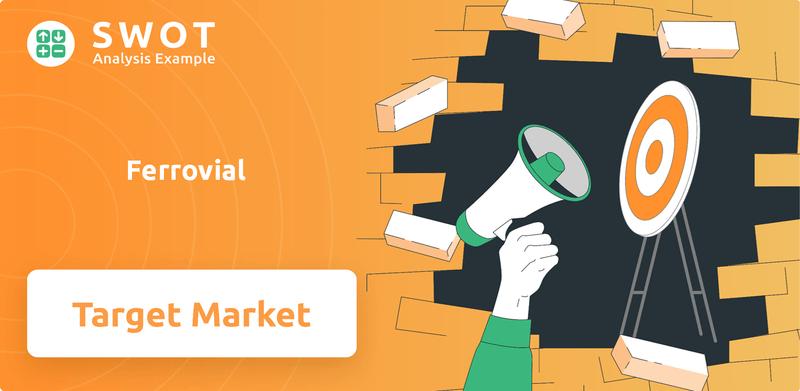
From its origins in post-war Spain to its current global presence, Ferrovial's customer profile has undergone a significant transformation. The company's journey reveals a strategic evolution, moving from primarily serving government needs to engaging with a broader range of stakeholders. A deeper dive into Ferrovial's customer base, including its Ferrovial SWOT Analysis, provides critical insights into its market positioning and future growth prospects. Understanding Ferrovial's target market analysis is key to appreciating its ability to adapt to changing global trends and customer needs.
Who Are Ferrovial’s Main Customers?
Understanding the customer demographics and target market of Ferrovial is crucial for grasping its business model. Ferrovial primarily operates within a Business-to-Business (B2B) and Business-to-Government (B2G) framework. This means its focus is on serving other businesses and governmental entities, rather than individual consumers.
The Ferrovial target market is diverse, encompassing entities with varying needs across the infrastructure lifecycle. This includes everything from the initial design and financing phases to the construction and ongoing operation of infrastructure projects. This approach allows Ferrovial to engage in large-scale projects with significant financial implications.
Ferrovial's customer profile is largely defined by its B2B and B2G engagements, which are critical to its revenue streams. The company's strategic focus on sustainable and innovative infrastructure solutions indicates an adaptation to evolving customer priorities. For more information about the company, you can read about Owners & Shareholders of Ferrovial.
In the B2G segment, Ferrovial's customers are typically public bodies. These include national transportation network authorities and municipal governments. These customers are driven by long-term public benefit, regulatory compliance, and budget considerations. Projects often involve complex procurement processes.
In the B2B segment, Ferrovial serves private companies. These can be real estate developers, industrial companies, or businesses involved in joint ventures. These customers are typically motivated by return on investment, operational efficiency, and meeting specific business objectives.
Ferrovial's key customer segments include national and local governments, public administrations, private developers, concessionaires, and large corporations. These segments are crucial for Ferrovial's revenue generation, with government contracts and partnerships with major corporations forming a significant portion of its income. The company's focus on sustainable infrastructure aligns with evolving customer needs.
While specific revenue breakdowns by customer segment are not publicly detailed for 2024-2025, Ferrovial's continued focus on large-scale public and private infrastructure projects suggests that government contracts and partnerships with major corporations remain its largest share of revenue. Ferrovial's 2023 revenue reached €8,514 million, with a significant portion derived from its construction and toll road divisions.
Ferrovial tailors its services to meet the specific needs of each customer group, whether public or private. This includes focusing on sustainable and innovative infrastructure solutions to meet evolving demands. The company's approach to customer acquisition involves a strategic focus on long-term partnerships and project-based engagements.
- Public sector clients prioritize reliability, regulatory compliance, and public benefit.
- Private sector clients focus on return on investment, operational efficiency, and specific business objectives.
- Ferrovial's customer relationship management involves close collaboration and project-specific solutions.
- The company's market share and customer reach are enhanced by its diverse portfolio of infrastructure projects.
Ferrovial SWOT Analysis
- Complete SWOT Breakdown
- Fully Customizable
- Editable in Excel & Word
- Professional Formatting
- Investor-Ready Format
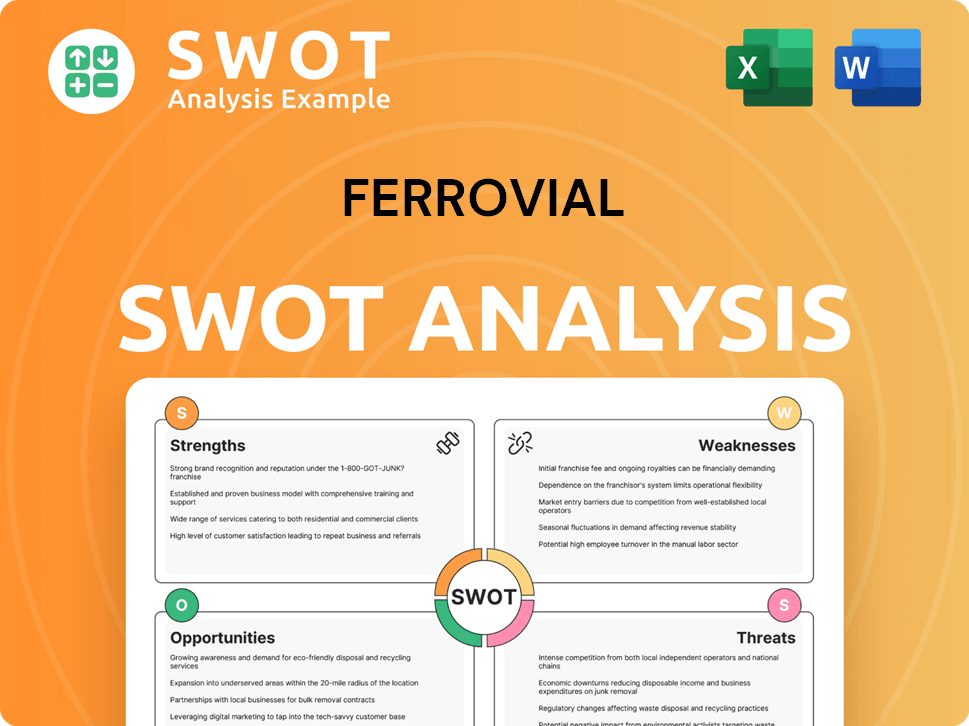
What Do Ferrovial’s Customers Want?
Understanding the customer needs and preferences is crucial for the success of any business, and for the infrastructure and construction industry, this is especially true. For Ferrovial, a deep understanding of its customer demographics is essential for tailoring its services effectively.
The primary customers of Ferrovial, which include governmental bodies and large corporations, have specific needs. They seek sustainable and resilient infrastructure, cost-effectiveness throughout the asset lifecycle, and the integration of innovative technologies. This customer-centric approach is key to Ferrovial's business strategy.
Ferrovial's customer profile is shaped by the demands of its target market. The company's focus on meeting these needs is reflected in its investment in areas like smart infrastructure and sustainable materials.
Public sector clients increasingly prioritize infrastructure projects that align with environmental, social, and governance (ESG) criteria. This includes solutions that reduce carbon footprints and enhance community well-being.
Purchasing behaviors are characterized by rigorous tender processes, detailed technical specifications, and a strong emphasis on proven experience and financial stability.
Ferrovial addresses common pain points such as project delays and budget overruns through its integrated approach to infrastructure development.
Feedback and market trends, particularly the accelerating pace of digitalization and the imperative for decarbonization, significantly influence Ferrovial's product development.
Decision-making criteria often involve a blend of technical merit, project timelines, risk management capabilities, and long-term operational costs.
The company is actively investing in areas like smart infrastructure, digital twins, and sustainable materials to meet these evolving demands.
Ferrovial's approach to customer acquisition and its ability to meet the needs of its target market are key to its success. The company's commitment to reducing its Scope 1 and 2 emissions by 46.2% by 2030, as approved by the Science Based Targets initiative (SBTi) in 2023, demonstrates its response to customer demand for sustainable solutions. This commitment showcases Ferrovial's dedication to its customer demographics and its ability to meet the evolving needs of its audience.
Ferrovial's key customer segments include governmental bodies, large corporations, and public sector clients, all of whom have specific needs and preferences.
- Governmental Bodies: Prioritize projects that align with ESG criteria, seeking sustainable and resilient infrastructure.
- Large Corporations: Focus on cost-efficiency, technical merit, and long-term operational costs.
- Public Sector Clients: Demand sustainable mobility and energy-efficient building designs.
- All Customers: Require solutions that alleviate project delays and budget overruns through an integrated approach.
Ferrovial PESTLE Analysis
- Covers All 6 PESTLE Categories
- No Research Needed – Save Hours of Work
- Built by Experts, Trusted by Consultants
- Instant Download, Ready to Use
- 100% Editable, Fully Customizable
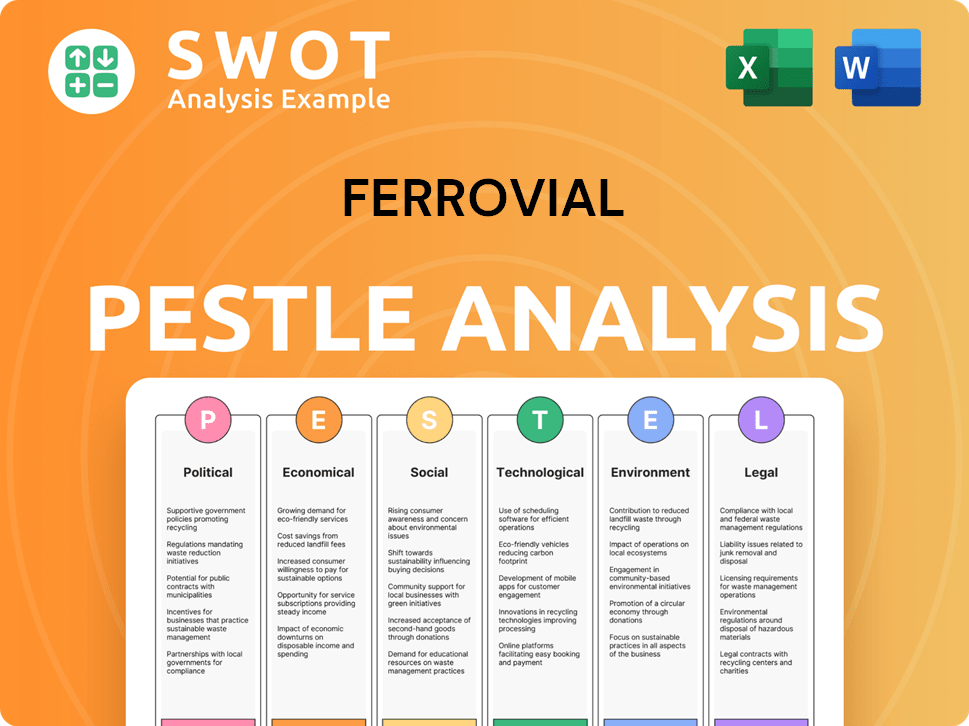
Where does Ferrovial operate?
The geographical market presence of Ferrovial is extensive, with significant operations across several continents. Its core markets include Spain, the United States, Canada, the United Kingdom, Poland, and Australia. This global footprint allows the company to engage in diverse infrastructure projects, from toll roads to airport management and construction.
In its home market of Spain, Ferrovial holds a strong market share, benefiting from a long history of delivering critical infrastructure projects. The United States has become a key growth area, particularly in toll roads and energy infrastructure. The company's strategic focus on core infrastructure assets reflects its dynamic response to market conditions and growth opportunities.
These diverse geographical locations require a localized approach to address the varied needs of the Ferrovial's business. The company adapts to regional regulatory frameworks, cultural nuances, and specific client requirements. This includes forming local partnerships and tailoring project delivery models to suit each regional context. Ferrovial’s strategic decisions, such as withdrawing from certain service businesses in 2023, are part of its broader strategy to optimize its geographic portfolio and enhance profitability.
Ferrovial's primary markets include Spain, the United States, Canada, the United Kingdom, Poland, and Australia. These regions represent significant opportunities for infrastructure development and investment.
The North American operations, including assets like the I-66 Express Mobility Partners in Virginia and the North Tarrant Express in Texas, generated €1,540 million in revenue in 2023 from its toll road division, showing the market's importance.
Ferrovial localizes its offerings by adapting to regional regulatory frameworks, cultural nuances, and specific client requirements. This ensures projects meet local needs and standards.
The company’s strategic withdrawal from certain service businesses in 2023 and its focus on core infrastructure assets are part of its broader strategy to optimize its geographic portfolio and enhance profitability.
Ferrovial Business Model Canvas
- Complete 9-Block Business Model Canvas
- Effortlessly Communicate Your Business Strategy
- Investor-Ready BMC Format
- 100% Editable and Customizable
- Clear and Structured Layout
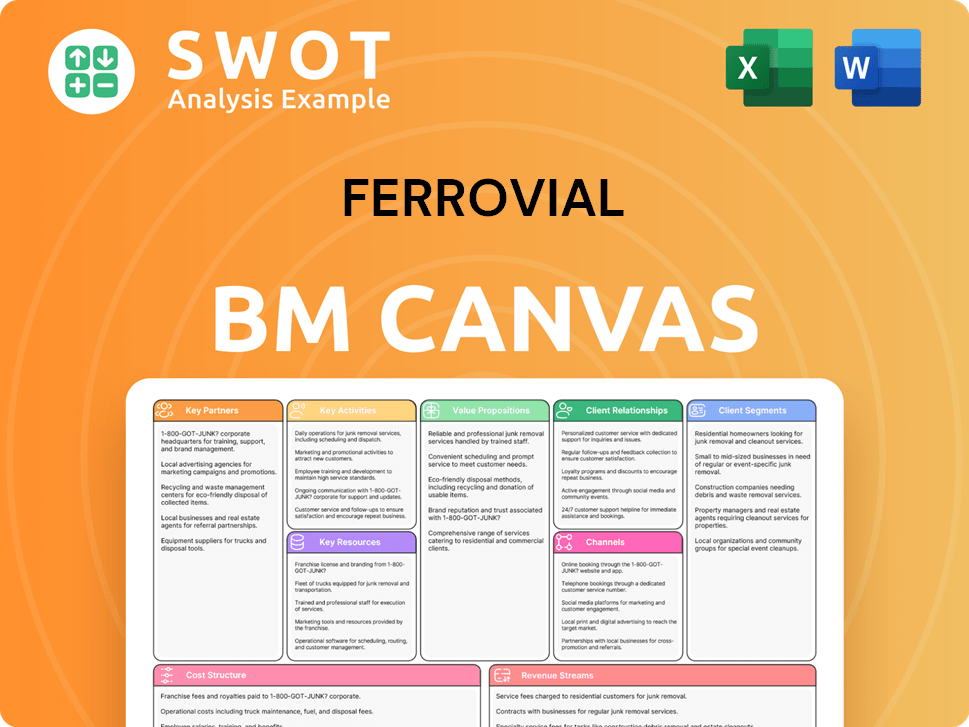
How Does Ferrovial Win & Keep Customers?
The customer acquisition and retention strategies of Ferrovial are largely focused on its B2B and B2G client base. The company concentrates on long-term relationships, showcasing expertise, and competitive tendering processes. This approach is crucial for securing and maintaining significant infrastructure projects.
Marketing efforts at Ferrovial are tailored to specific audiences. Instead of mass-market advertising, the company uses targeted outreach, attends industry conferences, and directly engages with governmental bodies and private developers. Digital channels are also important for displaying project portfolios and thought leadership in sustainable infrastructure.
Sales tactics involve detailed proposal development and competitive bidding. Ferrovial's ability to provide comprehensive solutions, including financing, design, construction, and operation, is a key competitive advantage. Customer data and CRM systems are used to manage client relationships and identify new opportunities. Understanding the specific needs of different governmental departments or private industry sectors through segmentation allows for tailored proposals.
Ferrovial's customer acquisition strategy emphasizes long-term relationships with B2B and B2G clients. This includes strategic partnerships and direct engagement, focusing on demonstrating expertise in infrastructure projects. The company secures contracts through competitive bidding and comprehensive proposal development.
Ferrovial uses targeted marketing channels, including industry conferences and direct engagement with key stakeholders. Digital platforms showcase project portfolios and thought leadership. This targeted approach helps to reach the right audience and highlight the company's strengths.
Sales tactics involve detailed proposal development and competitive bidding. Ferrovial's ability to offer comprehensive solutions, including financing, design, construction, and operation, provides a significant competitive advantage. This comprehensive approach helps secure major infrastructure contracts.
Customer data and CRM systems are crucial for managing client relationships and tracking project pipelines. Segmentation is applied to understand the specific needs of different governmental departments or private industry sectors, allowing for tailored proposals. This ensures effective client management.
Retention strategies at Ferrovial are built on successful project delivery, operational excellence, and post-completion support. For concession-based projects, long-term operational contracts inherently foster retention. The quality of work and adherence to timelines in construction projects also contribute to repeat business. Ferrovial's focus on safety, environmental performance, and social responsibility contributes to client trust and loyalty. The company's consistent success in securing major infrastructure contracts demonstrates the effectiveness of its client-centric approach and its ability to adapt to evolving market demands. For further insights, explore the Growth Strategy of Ferrovial.
Ferrovial Porter's Five Forces Analysis
- Covers All 5 Competitive Forces in Detail
- Structured for Consultants, Students, and Founders
- 100% Editable in Microsoft Word & Excel
- Instant Digital Download – Use Immediately
- Compatible with Mac & PC – Fully Unlocked
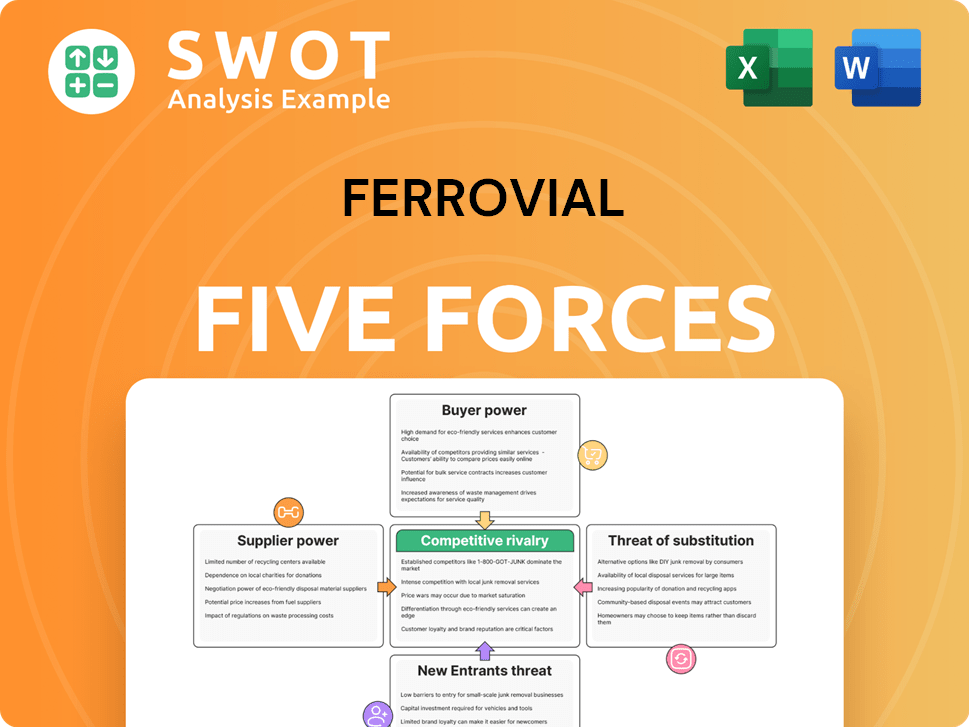
Related Blogs
- What are Mission Vision & Core Values of Ferrovial Company?
- What is Competitive Landscape of Ferrovial Company?
- What is Growth Strategy and Future Prospects of Ferrovial Company?
- How Does Ferrovial Company Work?
- What is Sales and Marketing Strategy of Ferrovial Company?
- What is Brief History of Ferrovial Company?
- Who Owns Ferrovial Company?
Disclaimer
All information, articles, and product details provided on this website are for general informational and educational purposes only. We do not claim any ownership over, nor do we intend to infringe upon, any trademarks, copyrights, logos, brand names, or other intellectual property mentioned or depicted on this site. Such intellectual property remains the property of its respective owners, and any references here are made solely for identification or informational purposes, without implying any affiliation, endorsement, or partnership.
We make no representations or warranties, express or implied, regarding the accuracy, completeness, or suitability of any content or products presented. Nothing on this website should be construed as legal, tax, investment, financial, medical, or other professional advice. In addition, no part of this site—including articles or product references—constitutes a solicitation, recommendation, endorsement, advertisement, or offer to buy or sell any securities, franchises, or other financial instruments, particularly in jurisdictions where such activity would be unlawful.
All content is of a general nature and may not address the specific circumstances of any individual or entity. It is not a substitute for professional advice or services. Any actions you take based on the information provided here are strictly at your own risk. You accept full responsibility for any decisions or outcomes arising from your use of this website and agree to release us from any liability in connection with your use of, or reliance upon, the content or products found herein.